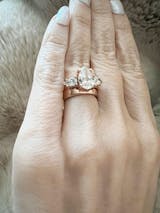Most of the gemstone cuts we’ve featured so far have been faceted, which means that they involve flat faces and straight edges to enhance brilliance and symmetry. There is another cut, equally beautiful but perhaps less popular: the cabochon cut.
In this post, we’ll describe what a cabochon cut is, the process for creating a cabochon, and finally the various ways a gemstone can benefit from a cabochon cut.
What is a Cabochon?
A cabochon is a gemstone that is instead shaped and polished. Thus, rather than appearing sharp and geometric, a cabochon is usually smoother and more rounded. The cut has become a popular alternative to faceted gemstones found in rings, necklaces and other jewelry pieces.
The word is derived from the French term caboche, which means head. Nowadays, gemstones cut as a cabochon are sometimes referred to as en cabochon gemstones or sometimes just cab for short. These typically include opals, turquoises, and moonstones.
Want to see what a real cabochon looks like? Take a look at our Rosados Box Petunia 14kt Yellow Gold Marquise Turquoise Leaves WITH Milgrain Tiara Ring. Notice how the gemstone is more opaque and rounded than a faceted gem.
How is a cabochon cut?
Cabochon cuts start with the selection of a rough stone. Any gemstone can be used, even wood can be made in cabochon. But some gemstones, like the opal or moonstone, are preferred for their opaque appearance and reflectivity ones smoothed.
`
The rough stone is “slabbed” which involves cutting the stone into ¼ or ½ inch thin slices. With the slab flat on a surface, a template and scribe are used to mark the shape of the cabochon.
Once the shape has been etched onto the slab, a trim saw is used to cut around the rough stone. To further grind the stone more accurately, cabochon machines use diamond or silicon carbide wheels. Water is sometimes added to protect the longevity of the wheels.
Finally, the stone is ready to be “dopped”. This involves applying jewelers wax to attach the stone to a “dop stick” which is essentially a wooden dowel. The remaining material is then grounded until it reaches the template line, until it is ultimately sanded and then polished using resin wheels and a polish pad.
Benefits of a cabochon cut
While almost any gemstone can be made in cabochon, opaque gemstones tend to be more popular as cabochons compared to when they are faceted. Especially for opaque gemstones, the goal of the cabochon cut is to help the gemstone appear fuller and denser, as opposed to more brilliant.
Some gemstones even have unique properties only visible when cut en cabachon. These include:
- Asterism - a star-like effect produced by rubies and sapphires
- Adularescence - a milky, bluish luster produced by moonstones and other gemstones
- Chatoyance - also known as the cat’s eye effect, produced by quarts and other gemstones
- Iridescence - a phenomenon of gradually changing colors depending on the perspective, seen on gemstones like opal
Cabochon cuts are also preferred when the gemstone is translucent or carries too many imperfections to be faceted. Cabochons retain the gemstone’s color but obscure any scratches or dirt that may appear on the surface. This also makes cabochons great for softer gemstones that are usually below a 7 on the MOHS scale.
Cabochons offer a wonderful alternative to faceted gemstones, highlighting unique gemstone effects while enhancing the size and density of the stone. It’s no wonder that it’s still used today. There’s simply nothing quite like it.
Curious to find our rings cut in cabochon? Visit our collection today.


































